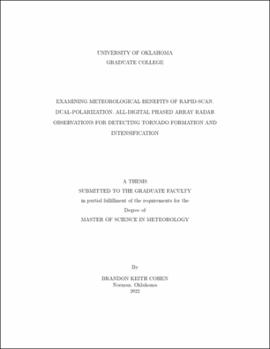| dc.description.abstract | Phased array radar (PAR) is widely considered the future for a replacement to the current operational radar network, NEXRAD. In particular, an all-digital operational PAR network offers a range of benefits including adaptive scanning techniques, higher temporal resolution especially via radar imaging modes, and denser vertical sampling to allow for more complete observations of severe hazard structure and evolution. This study focuses on the application of future operational phased array radar (PAR) systems to observe tornadoes and their formation. To best understand the benefits of a future all-digital operational PAR, we generate synthetic PAR observations from archived mobile rapid-scan observations collected by the Rapid X-band Polarimetric radar (RaXPol) to emulate typical operational radar ranges, PAR enabled scanning strategy effects, and NEXRAD and future possible PAR volumetric update times.
In this study, the synthetic PAR tool is applied to two datasets from RaXPol: the 24 May 2011 El Reno, Oklahoma, tornado and the 24 May 2016 Dodge City, Kansas, tornadoes. Range and azimuth averaging is applied over different windows to emulate different standoff ranges more comparable to operational, fixed-site radars. Using dealiased velocity data, we analyze the intensity of synthetic PAR tornado vortex signatures (TVSs) through a measure of the intensity of rotation (Delta-V) plotted as a function of time and height for each different standoff range. Despite increasingly coarse resolution, we find similar qualitative trends in the vertical evolution of TVS intensity even though the magnitude of Delta-V decreases. TVS intensification is found to occur in an ascending or simultaneous manner, even for data that has undergone spatial resampling to much longer standoff ranges (e.g., 80 km). Thus, it appears that detection of rapid TVS intensification occurring in an upward or simultaneous manner, as seen previously with mobile radars, can be used to detect tornadogenesis with future operational PARs. Additional work has focused on comparison of expected PAR revisit times in comparison to NEXRAD volume scan times. Update times of 60 s or faster are found enhance the data available to forecasters by better capturing critical evolution steps currently missed at NEXRAD update times (i.e., typical volume updates every 5–-6 min). However, at longer standoff ranges, a slight delay in observing the TVS intensification is found across tested temporal resolutions. We also observed some instances at longer standoff ranges where tornado-scale versus mesocyclone-scale TVS intensification may be occurring in different directions, particularly at 40 s and 5 min updates. Finally, we have analyzed the implementation of focusing, which shows promising results. Focusing could be used by an operational radar to enable updates faster than 60 s by targeted observations of specific storms or a region within a larger storm complex. Ultimately, through understanding the meteorological benefits from the synthetic PAR data, we should be able to contribute to improved planning for future all-digital operational PARs and warning decisions for tornadic storms. | en_US |

